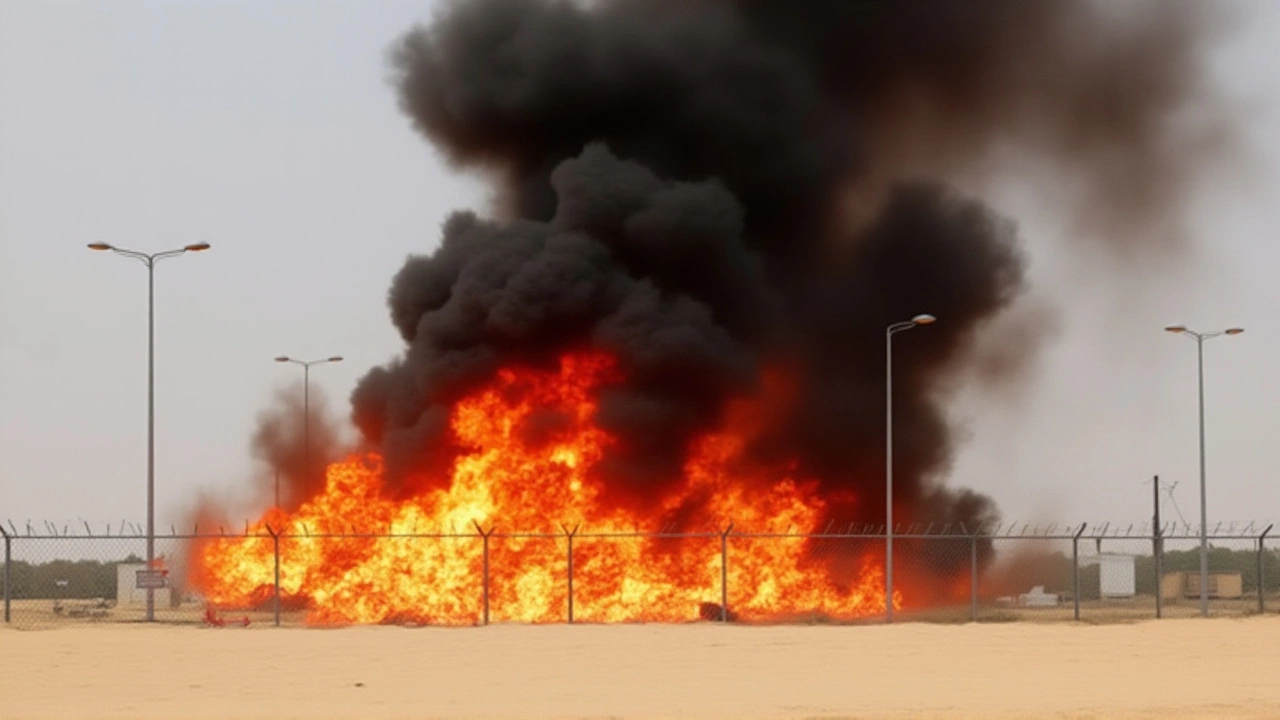Wing Commander Namansh Syal, a 34-year-old senior pilot of the Indian Air Force, died instantly when his Hindustan Aeronautics Limited (HAL) Tejas LCA Mk-1 crashed during a high-stakes aerobatic maneuver at the Dubai Air Show 2025Al Maktoum International Airport on November 21, 2025, at 2:11 PM UAE time. The aircraft, performing its final display of the week, entered an uncontrolled nose-dive during a low-altitude negative-G turn—just 30 feet above the tarmac—and exploded on impact near the runway. Spectators, diplomats, and fellow pilots watched in stunned silence as the jet, a symbol of India’s indigenous defense ambition, vanished in a fireball. The Dubai air show, running from November 17 to 21, had drawn over 1,500 exhibitors and 180 aircraft from 60 countries. Now, it’s remembered for tragedy.
What Happened in Those Final Seconds?
Eyewitness videos, later verified by Dubai Civil Aviation Authority investigators, show the Tejas banking sharply at near-zero altitude, then abruptly pitching upward before the nose snapped down violently. No smoke, no warning—just silence, then impact. The pilot, Wing Commander Syal, had flown over 1,200 hours in the Tejas and was among the IAF’s most experienced demonstration pilots. He was scheduled to end his routine with a tight barrel roll before a high-G climb, but the aircraft never recovered from the negative-G pull. No ejection was recorded. The crash site, just 200 meters from the VIP viewing zone, was cordoned off within minutes.Why This Crash Is Different
The Tejas program, launched in 2002, has endured 18 years of delays, technical setbacks, and two prior incidents—both non-fatal. This is the first time a pilot has died since the jet entered operational service in 2016. The Indian Air Force currently operates 40 Mk-1 variants, with 83 Mk-1A models on order. The aircraft’s fly-by-wire system, designed to prevent such stalls, reportedly functioned correctly according to preliminary black box data. But human factors, fatigue, and the extreme demands of air show flying may have played a role. The maneuver performed—known as a “low-altitude negative-G” —is rarely practiced in training. It’s high-risk, high-reward: dramatic for crowds, but unforgiving if the angle of attack slips by even a degree.International Reactions: Solidarity and Shock
The Captain Taylor "Fema" Hiester, a U.S. Air Force F-16 demonstration pilot from the United States Air Force based in Arlington, Virginia, didn’t just cancel his team’s final show—he publicly condemned the decision to continue. In an Instagram post that went viral, he wrote: “After two years of doing this job, that was a first for our team. To keep flying after a pilot just died? It felt wrong. Uncomfortable. Disrespectful.” His team’s withdrawal sent ripples through the event. Canada’s Snowbirds, France’s Patrouille de France, and the UK’s Red Arrows all paused their routines for a moment of silence. Only the UAE’s own Al Fursan team continued, drawing sharp criticism on social media.
The Cost of Showmanship
The Dubai Air Show organizers, under Fairs & Exhibitions LLC, maintained their schedule, citing “respect for the families of all participants” and “the importance of global defense diplomacy.” But in aviation circles, that rationale rang hollow. Air show safety protocols, established by the Fédération Aéronautique Internationale, recommend a 30-minute pause after any fatal incident. The Dubai event resumed after just two hours. “It’s not about logistics,” said retired Royal Air Force Wing Commander Linda Mistry, now an aviation safety consultant. “It’s about honoring the dead. When a pilot dies mid-show, the sky doesn’t belong to the organizers anymore. It belongs to grief.”What Comes Next for the Tejas Program?
The Indian Ministry of Defence in New Delhi confirmed a formal court of inquiry under Regulation 163 of the Air Force Act, 1950. Findings are expected within 90 days. The inquiry will examine flight data, pilot training records, weather conditions, and whether the Tejas was pushed beyond its certified envelope. HAL, headquartered in Bangalore, has pledged full cooperation. But analysts warn the crash could delay international sales. The Tejas was a key contender in bids from Argentina, Egypt, and the Philippines. “This isn’t just about one jet,” said defense analyst Rajiv Mehta. “It’s about trust. Can foreign air forces buy a fighter that killed a pilot on its biggest global stage?”
Who Was Wing Commander Namansh Syal?
Born in Chandigarh, Syal joined the IAF in 2013 after graduating from the National Defence Academy. He flew MiG-21s before transitioning to the Tejas in 2019. Colleagues described him as meticulous, calm under pressure, and deeply proud of India’s homegrown fighter. He was due to be promoted to Group Captain next year. His wife, Anjali Syal, and their two young children were in India when the news broke. The IAF has announced a full state funeral in New Delhi, with honors including a missing-man formation over the National War Memorial.Frequently Asked Questions
How common are fatal crashes during air shows?
Since 2000, there have been 17 fatal accidents during international air shows, averaging less than one per year. Most occur during low-altitude aerobatics, often due to pilot error, mechanical failure, or misjudged altitude. The Tejas crash is only the third involving an Indian military jet in the last 25 years, and the first at an overseas event. The U.S. Air Force’s Thunderbirds have had two fatal crashes since 1982; the Red Arrows, one since 1984.
Why didn’t the pilot eject?
The Tejas Mk-1’s ejection seat is rated for altitudes above 100 feet and speeds above 120 knots. At the moment of the crash, the aircraft was below 50 feet and slowing rapidly—likely too low and too slow for the system to function. Ejection requires milliseconds to arm, and the pilot may not have had time to initiate it. Black box data will confirm whether any ejection command was triggered.
Is the Tejas fighter jet safe for combat?
Yes. The Tejas has logged over 3,500 flight hours in operational service, including combat training and border patrols. Its safety record in actual missions is strong, with no combat losses. Air shows, however, push aircraft to their absolute limits—far beyond normal flight envelopes. This crash reflects the risks of demonstration flying, not inherent flaws in the jet’s combat design.
What’s the impact on India’s defense exports?
Immediate impact is likely. Countries like the Philippines and Egypt were close to signing deals. The crash will trigger renewed scrutiny of Tejas’ reliability under stress. But India’s defense ministry argues the jet’s performance in actual service remains unblemished. Long-term, the inquiry’s findings will matter more than the crash itself. If the cause is traced to pilot technique or air show protocol, exports may recover. If it’s a design flaw, the program could face years of delays.
Will the Dubai Air Show change its safety rules after this?
So far, organizers have not announced any policy changes. But pressure is mounting. The Fédération Aéronautique Internationale is reviewing whether to mandate a mandatory 24-hour pause after any fatality during multi-day air shows. The U.S. and European air forces have already signaled they’ll refuse to participate unless such rules are adopted. This crash may force global reform—not because of the jet, but because of how the world responded to its loss.
How is the Indian Air Force honoring Wing Commander Syal?
The IAF has declared a state funeral with full military honors in New Delhi, including a 21-gun salute and a missing-man flyover. His name will be engraved on the Air Force Memorial. A new Tejas training simulator at the Air Force Academy in Dundigal will be named after him. His wife and children will receive the full benefits of a fallen service member, including lifetime medical care and education support.

